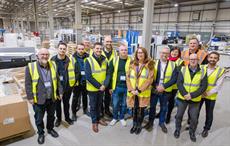National Composites Centre has unveiled its new Core Research Programme 2021/22, which has been designed to solve industry's biggest challenges in the use of advanced materials, with particular focus on sustainability and the hydrogen economy. More than half of the projects this year relate to enabling the use of hydrogen as a zero emissions fuel.
Composites are the enabling technology that will help the UK achieve Net Zero. Through the core research programme – a cross-sector, collaborative initiative involving the NCC’s member organisations now going into its 11th year – the world-leading research and development centre will find the solutions that will release industry to benefit from the unique properties composites can offer.National Composites Centre has unveiled its new Core Research Programme 2021/22, which has been designed to solve industry's biggest challenges in the use of advanced materials, with particular focus on sustainability and the hydrogen economy. More than half of the projects this year relate to enabling the use of hydrogen as a zero emissions fuel.#
With decarbonisation rapidly becoming a critical factor for many industries, more than half of the projects on this year’s programme are focused on enabling the use of hydrogen as a zero emissions fuel, and the recycling and re-use of composite materials.
Other topics of study include the design of composite structures for extreme environments, high-volume manufacturing of complex thermoplastic composite parts, and the performance of materials at very high temperatures.
Every year, NCC Tier 1 members drive the technical direction of the Core Research programme, and access research outputs over 15 times the value of their contribution through the collaborative nature of the programme. Tier 2 and associate members of the NCC can also access Core’s leading-edge research.
The projects in the Core Research Programme include that on Composite Cryogenic Tanks. To open up the hydrogen economy in transport, storage tanks must be light and safe, something composites can offer. This project is at the forefront of developing the testing methodologies needed to understand which materials perform best at the very low temperatures required.
Another project is on Composite Pressure Vessel Hydrogen Permeability. Due to its tiny molecules, storing and transporting hydrogen gas is a challenge. By enhancing knowledge of how high-pressure storage needs to be designed and manufactured to ensure it doesn’t leak, the composites solution can be found.
Projects on sustainability include recycling end-of-life composites, recycling of composite manufacturing waste, composite design for sustainability and recycled composites supply chain.
There is also a project on composite interface and durability. The project will develop the best practices and tools for successful joint design and qualification to increase adoption in subsea structures and applications.
The programme also has projects on overmoulding of butt jointed aerostructures, fire resistant structural composites, and modular infusion which allows different sections of a single part to be manufactured independently from each other.
Fibre2Fashion News Desk (SV)


